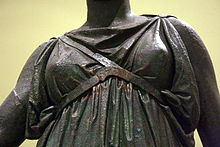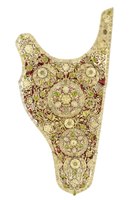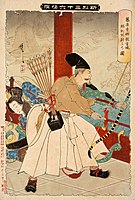Quiver: Difference between revisions
m Reverted 1 edit by 173.220.26.146 (talk) to last revision by FrescoBot. (TW) |
No edit summary Tags: Visual edit Mobile edit Mobile web edit |
||
| (31 intermediate revisions by 29 users not shown) | |||
| Line 1: | Line 1: | ||
{{short description|Container for holding arrows, bolts, darts, ammo, projectiles or javelins}} |
|||
{{Other uses}} |
{{Other uses}} |
||
{{redirect|Quiver of arrows|the poetry collection|Quiver of Arrows: Selected Poems, 1986–2006|the 1980 story anthology|A Quiver Full of Arrows|the U.S. Christian movement|Quiverfull}} |
|||
{{ |
{{more citations needed|date=May 2013}} |
||
[[File:Wenceslas Hollar - Quivers and hunting horns.jpg|thumb|Three quivers |
[[File:Wenceslas Hollar - Quivers and hunting horns.jpg|thumb|Three quivers]] |
||
A '''quiver''' is a container for holding [[arrow]]s |
A '''quiver''' is a container for holding [[arrow]]s or [[Crossbow bolt|bolts]]. It can be carried on an archer's body, the bow, or the ground, depending on the type of shooting and the archer's personal preference. Quivers were traditionally made of leather, wood, furs, and other natural materials, but are now often made of metal or plastic. |
||
==Etymology== |
|||
The English word '''quiver''' has its origins in [[Old French]], written as quivre, cuevre, or coivre.{{sfn|Chisholm|1911|loc=''Quiver''}} |
|||
==Types== |
==Types== |
||
| Line 9: | Line 14: | ||
===Belt quiver=== |
===Belt quiver=== |
||
The most common style of quiver is a flat or cylindrical container suspended from the belt. They are found across many cultures from North America to China. Many variations of this type exist, such as being canted forwards or backwards, and being carried on the dominant hand side, off-hand side, or the small of the back. Some variants enclose almost the entire arrow, while minimalist "pocket quivers" consist of little more than a small stiff pouch that only covers the first few inches. |
The most common style of quiver is a flat or cylindrical container suspended from the belt. They are found across many cultures from North America to China. Many variations of this type exist, such as being canted forwards or backwards, and being carried on the dominant hand side, off-hand side, or the small of the back. Some variants enclose almost the entire arrow, while minimalist "pocket quivers" consist of little more than a small stiff pouch that only covers the first few inches. The [[Bayeux Tapestry]] shows that most bowmen in medieval Europe used belt quivers. |
||
===Back quiver=== |
===Back quiver=== |
||
[[File:7333 - Piraeus Arch. Museum, Athens - Artemis - Photo by Giovanni Dall'Orto, Nov 14 2009.jpg|thumb|A y-shaped harness for a back quiver features on this bronze statue of [[Artemis]], goddess of the hunt, mid-4th century BC.]] |
|||
Back quivers are secured to the archer's back |
Back quivers are secured to the archer's back by leather straps, with the [[Nock (arrow)|nock]] ends protruding above the dominant hand's shoulder. Arrows can be drawn over the shoulder rapidly by the nock. This style of quiver was used by [[Indigenous peoples of the Americas|native peoples of North America]] and Africa, and was also commonly depicted in bas-reliefs from ancient [[Assyria]]. They were also used in Ancient Greece and often feature on sculptural representations of Artemis, goddess of the hunt. While popular in cinema and 20th century art for depictions of medieval European characters (such as [[Robin Hood]]), this style of quiver was rarely used in medieval Europe.<ref name="English Longbowman">{{cite book |author1=Gerry Embleton |author2=Clive Bartlett |title=English Longbowman 1330-1515Ad (Warrior, No 11) |publisher=Osprey Publishing (UK) |year=1995 |pages=28 |isbn=1-85532-491-1 }}</ref> |
||
===Ground quiver=== |
===Ground quiver=== |
||
| Line 21: | Line 27: | ||
===Arrow bag=== |
===Arrow bag=== |
||
A style used by medieval [[English |
A style used by medieval [[English longbow]]men and several other cultures, an arrow bag is a simple drawstring cloth sack with a leather spacer at the top to keep the arrows divided. When not in use, the drawstring could be closed, completely covering the arrows so as to protect them from rain and dirt. Some had straps or rope sewn to them for carrying, but many either were tucked into the belt or set on the ground before battle to allow easier access. |
||
===Japanese quivers=== |
===Japanese quivers=== |
||
| ⚫ | |||
| ⚫ | |||
==Gallery== |
==Gallery== |
||
<gallery> |
<gallery widths="200px" heights="200px"> |
||
Image:OttomanHorseArcher.jpg|An [[Ottoman Turk]] with a rear-canted belt quiver designed for [[mounted archery]] |
Image:OttomanHorseArcher.jpg|An [[Ottoman Turk]] with a rear-canted belt quiver designed for [[mounted archery]] |
||
File:Bågkoger med förgyllt silver, peridoter, små turkoser, rubiner och silverpärlor - Livrustkammaren - 91418.tif|Quiver from Turkey, 1620s. |
File:Bågkoger med förgyllt silver, peridoter, små turkoser, rubiner och silverpärlor - Livrustkammaren - 91418.tif|Quiver from Turkey, 1620s. |
||
Image:Antique Japanese (samurai) yumi and yebira.jpg|Japanese archery equipment including a variety of quivers |
Image:Antique Japanese (samurai) yumi and yebira.jpg|Japanese archery equipment including a variety of quivers |
||
Image:Yoshitoshi Fujiwara no Hidesato.jpg|Fujiwara no Hidesato shooting the giant centipede ([[Tsukioka Yoshitoshi]], 1890) |
Image:Yoshitoshi Fujiwara no Hidesato.jpg|Fujiwara no Hidesato shooting the giant centipede ([[Tsukioka Yoshitoshi]], 1890) |
||
File:Detail. Royal guard carrying a quiver, member of the so-called Immortals (the 1000 special royal guards). Glazed brick. From the East Gate of the Palace at Susa, Iran. Achaemenid period, Reign of Darius I, 521-500 BCE. British Museum.jpg|Detail. Royal guard carrying a quiver, member of the so-called Immortals (the 1000 special royal guards). From Susa, Iran. 521-500 BCE. British Museum |
|||
</gallery> |
</gallery> |
||
==See also== |
|||
* [[Gorytos]] |
|||
==Notes== |
==Notes== |
||
{{ |
{{Reflist}} |
||
==References== |
==References== |
||
*{{cite book |title=Archery |publisher=Boy Scouts of America |location=Irving, Texas |year=1986 |
* {{cite book |title=Archery |publisher=Boy Scouts of America |location=Irving, Texas |year=1986 |isbn=0-8395-3381-0 }} |
||
| ⚫ | |||
*{{cite book |author1=Glover, Daniel S. |author2=Grayson, Charles Jackson |author3=French, Mary |author4=O'Brien, Michael J. |title=Traditional archery from six continents: the Charles E. Grayson Collection |publisher=University of Missouri Press |location= |
* {{cite book |author1=Glover, Daniel S. |author2=Grayson, Charles Jackson |author3=French, Mary |author4=O'Brien, Michael J. |title=Traditional archery from six continents: the Charles E. Grayson Collection |publisher=University of Missouri Press |location=Columbia |year=2007 |isbn=0-8262-1751-6 }} |
||
Columbia |year=2007 |pages= |isbn=0-8262-1751-6 |oclc= |doi= |accessdate=}} |
|||
Dr. Brian Marin, author of Ancient Warfare| Concordia Press| page 137 |
|||
==External links== |
|||
{{Commons category|Quivers}} |
|||
{{wiktionary}} |
|||
| ⚫ | |||
{{Archery}} |
{{Archery}} |
||
{{Authority control}} |
|||
[[Category:Archery]] |
[[Category:Archery]] |
||
Latest revision as of 01:05, 13 June 2024
This article needs additional citations for verification. (May 2013) |

A quiver is a container for holding arrows or bolts. It can be carried on an archer's body, the bow, or the ground, depending on the type of shooting and the archer's personal preference. Quivers were traditionally made of leather, wood, furs, and other natural materials, but are now often made of metal or plastic.
Etymology
[edit]The English word quiver has its origins in Old French, written as quivre, cuevre, or coivre.[1]
Types
[edit]Belt quiver
[edit]The most common style of quiver is a flat or cylindrical container suspended from the belt. They are found across many cultures from North America to China. Many variations of this type exist, such as being canted forwards or backwards, and being carried on the dominant hand side, off-hand side, or the small of the back. Some variants enclose almost the entire arrow, while minimalist "pocket quivers" consist of little more than a small stiff pouch that only covers the first few inches. The Bayeux Tapestry shows that most bowmen in medieval Europe used belt quivers.
Back quiver
[edit]
Back quivers are secured to the archer's back by leather straps, with the nock ends protruding above the dominant hand's shoulder. Arrows can be drawn over the shoulder rapidly by the nock. This style of quiver was used by native peoples of North America and Africa, and was also commonly depicted in bas-reliefs from ancient Assyria. They were also used in Ancient Greece and often feature on sculptural representations of Artemis, goddess of the hunt. While popular in cinema and 20th century art for depictions of medieval European characters (such as Robin Hood), this style of quiver was rarely used in medieval Europe.[2]
Ground quiver
[edit]A ground quiver is used for both target shooting or warfare when the archer is shooting from a fixed location. They can be simply stakes in the ground with a ring at the top to hold the arrows, or more elaborate designs that hold the arrows within reach without the archer having to lean down to draw.
Bow quiver
[edit]A modern invention, the bow quiver attaches directly to the bow's limbs and holds the arrows steady with a clip of some kind. They are popular with compound bow hunters as it allows one piece of equipment to be carried in the field without encumbering the hunter's body.
Arrow bag
[edit]A style used by medieval English longbowmen and several other cultures, an arrow bag is a simple drawstring cloth sack with a leather spacer at the top to keep the arrows divided. When not in use, the drawstring could be closed, completely covering the arrows so as to protect them from rain and dirt. Some had straps or rope sewn to them for carrying, but many either were tucked into the belt or set on the ground before battle to allow easier access.
Japanese quivers
[edit]Yebira refers to a variety of quiver designs. The Yazutsu is a different type, used in Kyudo. Their main use is to transport and protect arrows.
Gallery
[edit]-
An Ottoman Turk with a rear-canted belt quiver designed for mounted archery
-
Quiver from Turkey, 1620s.
-
Japanese archery equipment including a variety of quivers
-
Fujiwara no Hidesato shooting the giant centipede (Tsukioka Yoshitoshi, 1890)
-
Detail. Royal guard carrying a quiver, member of the so-called Immortals (the 1000 special royal guards). From Susa, Iran. 521-500 BCE. British Museum
See also
[edit]Notes
[edit]- ^ Chisholm 1911, Quiver.
- ^ Gerry Embleton; Clive Bartlett (1995). English Longbowman 1330-1515Ad (Warrior, No 11). Osprey Publishing (UK). p. 28. ISBN 1-85532-491-1.
References
[edit]- Archery. Irving, Texas: Boy Scouts of America. 1986. ISBN 0-8395-3381-0.
- Chisholm, Hugh, ed. (1911). . Encyclopædia Britannica. Vol. 22 (11th ed.). Cambridge University Press.
- Glover, Daniel S.; Grayson, Charles Jackson; French, Mary; O'Brien, Michael J. (2007). Traditional archery from six continents: the Charles E. Grayson Collection. Columbia: University of Missouri Press. ISBN 0-8262-1751-6.






